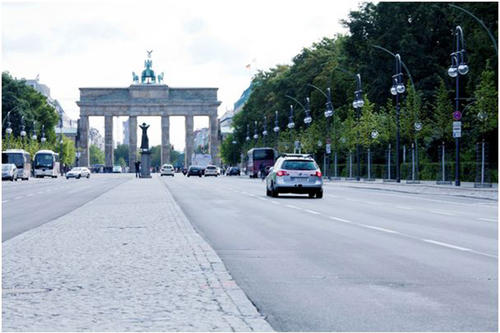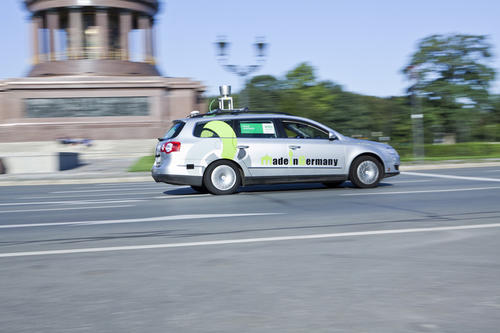Brandenburg Gate Mission Accomplished
Autonomous Car Navigates the Streets of Berlin
№ 291/2011 from Sep 17, 2011
MadeInGermany is the first car licensed for autonomous driving on the streets and highways in the German state of Berlin.
Image Credit: Claudia Heinstein
The car MadeInGermany was developed by the AutoNOMOs Labs, a university project funded by the German Federal Ministry of Education and Research.
Image Credit: Claudia Heinstein
Researchers from Freie Universität Berlin traveled 80 km in total as passengers during a test drive of their autonomous car “MadeInGermany” over the weekend. The car is driven by computers – the safety driver behind the steering wheel only monitors the car’s behavior. The autonomous car is a conventional VW Passat modified for “drive by wire.” Electronic commands from the computer are passed directly to the accelerator, the brakes, and the steering wheel of the vehicle. Multiple sensors integrated in the car’s chassis provide information about all cars or persons on the street. They allow the car to avoid obstacles, adjust its speed, or change lanes whenever necessary. The vehicle was shown in full Berlin traffic and covered the 20 km back and forth between the International Congress Center and Brandenburg Gate four times without any incidents.
MadeInGermany is the first car licensed for autonomous driving on the streets and highways of the German state of Berlin. The car was developed by the AutoNOMOs Labs, a university project funded by the German Federal Ministry of Education and Research. The objective of the project is to develop technology that can be transferred to driver assistance systems, to innovative safety systems for conventional cars, or to full autonomous vehicles in private enclosures such as airports or mines. The Berlin researchers have been working on autonomous cars since 2007. The newest car was certified in June of 2011 for autonomous driving and has already covered thousands of kilometers autonomously during the test drives in the days previous to the public demonstration this weekend. The car was tested extensively. As a condition for the driving permit, a safety driver has to be behind the wheel during the tests: if the safety driver touches the brake pedal all computers disconnect and the safety driver can take control of the vehicle.
The car recognizes its position on the Berlin streets from a very accurate GPS unit and a map of the city. Three laser scanners at the front, and three at the rear of the vehicle detect any car or pedestrian 360 degrees around the car. The measurements are done by emitting laser pulses in the invisible infrared region. The echo of the light pulses is detected, and its flight time determines the distance to objects. A rotating laser scanner on top of the vehicle provides additional measurements – up to one million scan points per second of the 3D structure of the environment. A black and white video camera behind the rear view mirror is used to detect the white lane strips and center the car on its lane. Two color cameras are used to identify traffic lights and their state. During the test drive in Berlin, the car processed 46 traffic lights successfully during each of the four runs.
In the opinion of Prof. Raul Rojas, leader of the project, autonomous vehicles could already be used on private roads since the technology is mature. Driving autonomously on public highways could become acceptable within the next ten to fifteen years, once thorny legal issues have been sorted out. Navigating autonomously in the streets requires additional technological development in order to make the cars extremely safe. “The standards used to measure safety in autonomous cars will be far more severe than for humans,” says Prof. Rojas, “but once all the pieces fall into place, autonomous cars will be safer than cars driven by persons. It is just a matter of time.”
AutoNOMOS Labs sees its research as part of a trend toward green cars. Car sharing is still inconvenient because the customers have to retrieve the car and take it back to the rental stations. Shared cars of the future will pick up the customers, maybe two or three neighbors at the same time, will drive them to their working place, or to the subway. They will continue serving other customers after the first passengers have left the vehicle, that is, they will act like autonomous taxicabs. In combination with public transportation, a city like Berlin could be fully covered with only 10% of the current number of vehicles in the city.
MadeInGermany will continue driving the Berlin streets during the next months. The researchers at AutoNOMOS Labs now have a new goal: fully autonomous driving between European cities.
Further Information
- Raúl Rojas, Artificial Intelligence Group, Institute of Computer Science, Freie Universität Berlin, Tel.: +49 (0)30 / 838 – 75102, Email: rojas@inf.fu-berlin.de
- Tinosch Ganjineh, Artificial Intelligence Group, Institute of Computer Science, Freie Universität Berlin, Tel.: +49 (0)30 / 838-75128, Email: ganjineh@inf.fu-berlin.de
- Patrick Vogel, Chief Financial Officer, Tel.: +49 (0)30 / 838-75149, Email: patrick.vogel@fu-berlin.de


